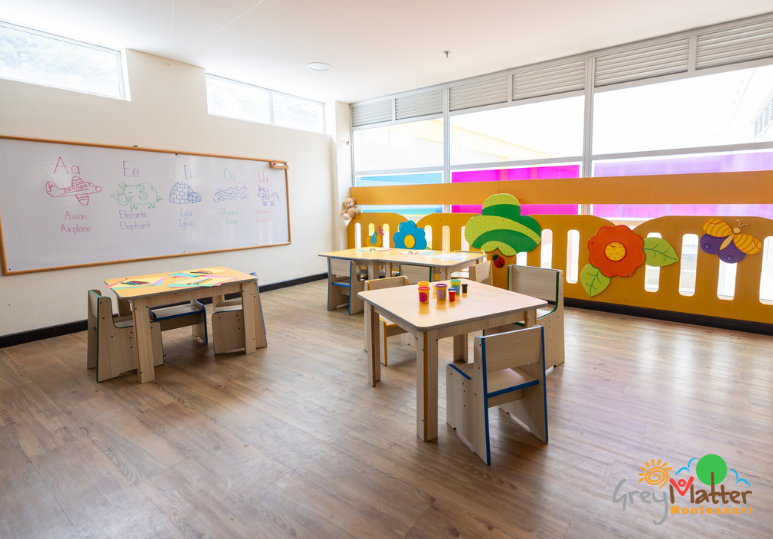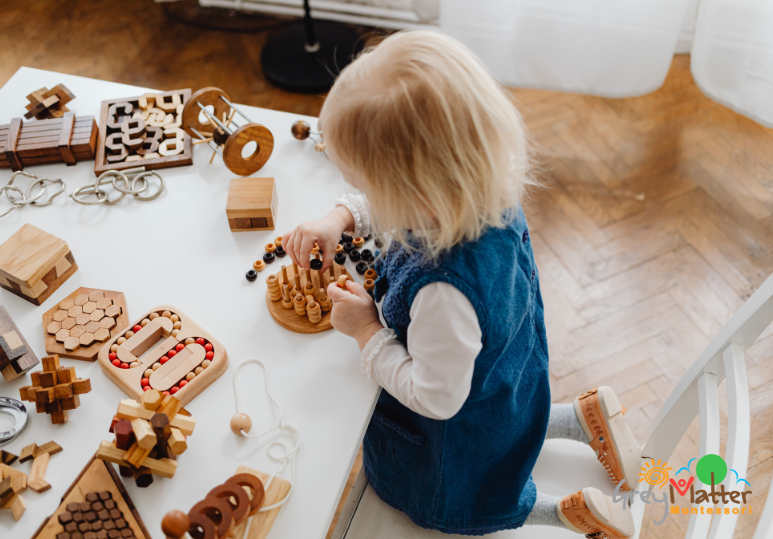Why Curiosity and Independence Grow Together
Montessori links freedom with responsibility. Children choose from a curated set of activities, use them carefully, then return them ready for the next person. This simple pattern of choose, concentrate, complete, restore turns interest into purposeful practice. Expectations are clear, such as quiet voices, gentle hands, and respect for others’ work, so exploration feels safe instead of chaotic. Guides step in with brief demonstrations, then step back, allowing time for repetition and refinement. Over time, children experience many small wins. These successes build judgement, stamina, and the confidence to try a new challenge without waiting for an adult to lead.
Prepared Environments That Invite Questions and Curiosity
A Montessori classroom is designed at the child’s scale. Materials are visible and accessible, with one clear purpose per tray. A pouring activity strengthens control of movement. The pink tower isolates size, while sound cylinders isolate pitch. By removing distractions, the environment encourages careful looking, comparing, and testing. Because everything has a place, children plan their own sequences and return items independently. The room itself teaches order, patience, and stewardship.
Freedom Within Clear Limits
Choice matters, but limits protect focus. Children select what to work on, where to sit, and how long to concentrate, within simple community rules. Only one material is used at a time. Work is carried on a tray or mat to define space. Items are returned ready for the next person. A long, uninterrupted work cycle allows deeper concentration and the satisfaction that comes from finishing well. These routines quietly build executive function without constant reminders.
The Guide’s Role: Precise Help, Then Trust
Montessori guides observe readiness, then present short, hands-on lessons. A sandpaper letter is traced with two fingers while the sound is named. A golden bead exchange shows, not tells, how ten units become a ten bar. After a lesson, the guide withdraws so the child can practise privately. Errors are part of learning and materials are self-correcting. Adults resist the urge to step in too soon, which teaches that effort changes outcomes. Children learn to notice, adjust, and try again.
Practical Life: Real Skills, Real Confidence
Practical life is the heart of early independence. Children pour, spoon, polish, sew, wash tables, and care for plants. These tasks refine coordination and build the habit of finishing what they start. They also transfer home. A child who can button, sweep, and pour gains meaningful responsibility and pride, which supports calm mornings and smoother transitions.
Sensorial: Training The Senses For Thinking
Sensorial materials isolate qualities like colour, texture, weight, and shape. Matching, grading, and naming develop careful perception and vocabulary. This attention to detail becomes the base for scientific thinking. When children can compare and describe what they notice, they are ready to classify, measure, and reason.
Language: From Sound to Symbol
Language begins with rich conversation and stories, then moves to sound games, sandpaper letters, and the moveable alphabet. Writing often arrives before reading because children can build words with tangible letters. Success with early writing grows motivation for decoding print. Small, repeated steps make literacy feel attainable and enjoyable.
Mathematics: Concrete To Abstract
Montessori math materials let children hold quantity in their hands. Number rods and bead bars build number sense. Golden beads show the decimal system and the logic of exchanges. Operations are acted out with real objects before moving to symbols. This sequence creates understanding that lasts.
Grace, Courtesy, And Community
Independence is not isolation. Short, practised lessons on how to interrupt politely, offer help, and solve small conflicts give children scripts for kindness. Multi-age communities bring natural mentorship. Younger children learn by watching. Older children deepen mastery by demonstrating. The classroom becomes a place where contribution is expected and valued.
A Day That Supports Self-Motivation
Predictable routines reduce friction. Children arrive, choose work, and settle into the work cycle. Movement is built in through carrying materials, rolling rugs, and choosing floor or table work, which channels energy and supports focus. Outdoor time brings fresh air and gross motor practice. The day closes with simple reflections or group stories, reinforcing calm transitions and shared pride in the environment.
Building Confidence That Lasts with Grey Matter
Montessori preschool nurtures curiosity and independence through calm routines, hands-on materials, and respectful guidance that lets children discover for themselves. At Grey Matter Montessori in NW Calgary, children ages 3–6 choose meaningful work, care for their environment, and build the confidence to try, practise, and master new skills. These daily habits become a foundation for later academics and personal growth. If you are exploring preschool options, contact Grey Matter Montessori to learn more about how our approach could be the right fit for your child.
FAQs
Q: What ages does Montessori preschool serve?
A: Grey Matter Montessori welcomes children ages 3–6 at our NW location. At our NE location, we offer programs for children aged 19 months to 6 years; Offering a mixed-age classroom where curiosity and leadership develop naturally. Contact Grey Matter Montessori today to find out more about our programs.
Q: How does Montessori encourage curiosity?
A: Materials and lessons are designed for self-discovery. Children explore freely, test ideas, and learn through hands-on experience.
Q: Will my child learn independence at a Montessori preschool?
A: Yes. Children are guided to choose work, care for their space, and complete tasks on their own, building self-confidence and responsibility.






